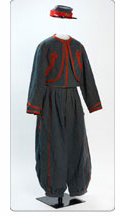Rare uniform donated to War Museum
January 28, 2013
In the mid-1860s, a call goes out from Pope Pius IX to Catholic men worldwide: Come to Rome to defend the Papal Territories against the nationalist armies fighting for unification of the Italian states. Five thousand men heed the call. They come from the Netherlands, Poland, France, Belgium, Ireland, England, Prussia, the United States, Spain—and five hundred come from Quebec.
These were the Papal Zouaves, a fighting force modelled after light infantry regiments of the French Army serving in colonial North Africa. These origins are reflected in the distinctive Papal Zouave uniform, one of which was recently donated to the Canadian War Museum by a great-grand daughter of Jean-Baptiste Drolet.
Quebec’s papal soldiers, most young and unmarried, were recruited from across the province by the Bishop of Montréal, Monseigneur Ignace Bourget, starting in November 1867. The Bishop had been told by Rome that if he recruited five hundred men they would form their own battalion, instead of being distributed among the existing battalions. The bishop’s campaign was so successful potential recruits had to be turned away. The Quebec battalion was the largest military contingent of Canadians to serve overseas until the South African War (1899–1902).
In Rome, the Canadians fought bandits and guerrillas in the surrounding hills, suffering few deaths. But their military duty was short-lived. In September 1870, a large Italian army entered Rome, removing the Pope from political power. The Zouaves were disbanded.
Personal connection to history
Twenty-six year old Jean-Baptiste Drolet returned to Quebec, where he was granted land near the village of St. Alexis des Monts in the Laurentian Mountains. He ran the village’s first post office, served as mayor, and, with his wife Louise, raised 12 children. He died on May 15, 1927 at the age of 83.
His uniform was preserved by his descendants—which makes it especially compelling for the War Museum. “This is the first Papal Zouave uniform we have acquired and we like to have personal stories associated with artifacts,” explains Collections Manager Arlene Doucette. “It was donated by a direct descendant and Jean-Baptiste Drolet is mentioned in contemporary records—there’s even a photo of him wearing it. The uniform itself is visually striking, with a French colonial look quite different from the military traditions represented by most of our uniform collection. We’re very grateful for the donation.”